An In depth 2023 Shoppers Guide To Shun Sora, Classic, Dual Core, Kanso, Premiere, Blue and Classic Pro Knives and Block Sets
Shun knives are often hailed as top of the line for Japanese cutlery. A lot of chefs will tell you they’re also overpriced, and maybe they’re right, but Shun has a certain assurance of quality and style that you don’t get with a lot of other brands. Which is one reason we always enjoy reviewing them. Whatever the price, Shun is a fantastic knife that makes either a great gift or addition to a block set you already have.
One of the benefits of getting into Shun knives is they have a pretty decent customer service who are generally helpful for anyone who’s not exactly an expert. They put out quite a bit of content out there that’s helpful for beginners (or not-quite beginners who are too afraid to ask at this point), and like any good company wanting to stay in the good graces of its customers, they offer free sharpening on all their knives.
At the moment, Shun produces seven different sets, and even though they’re all mostly Japanese-style, there are a few differences that separate them in terms of ideal use and skill level. We’ll try to cover them here as comprehensively as we can, with the exception of their limited releases. It’s also worth mentioning they make series like the Seki Magoroku series, but don’t offer them as a set (yet), so there’s more options for mixing and matching with your knife block than you might think.
This post has been updated for 2023. We will add new knife series and sets to this article as Shun releases them.
Sora
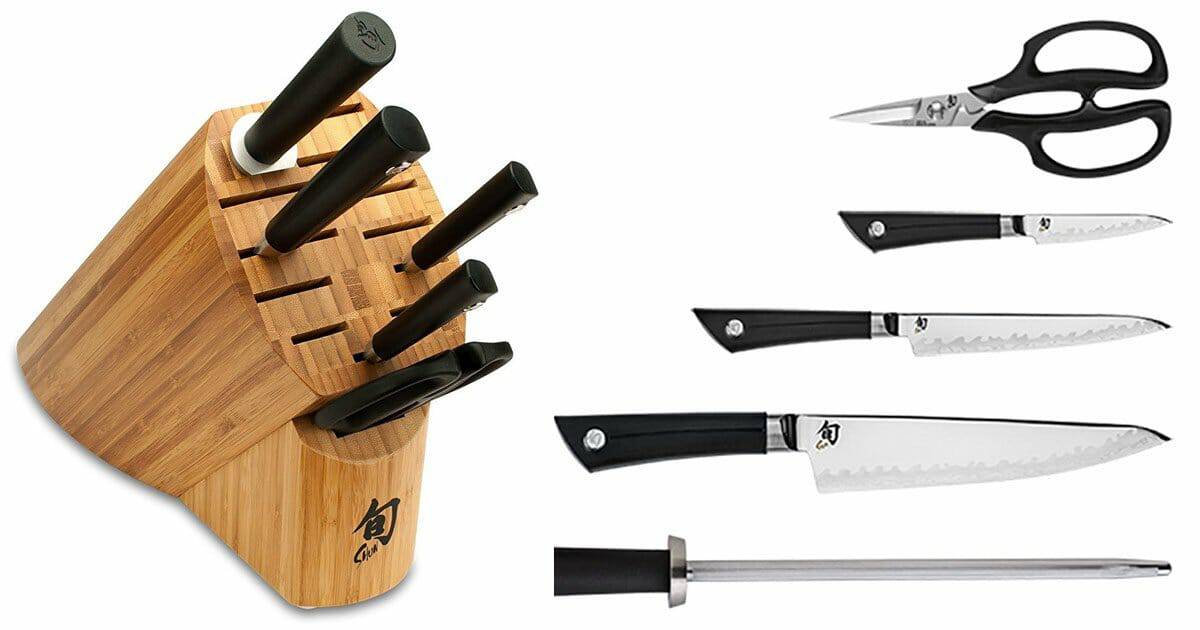
Shun Sora 6 Piece Block Set Specifications
| VG-10/420J steel |
| Double bevel grind |
| Textured PP/TP handles |
Pros
| Comfortable handles |
| Good edge retention |
| More affordable Shun option |
| Easy to find sets |
Cons
| Not as visually striking |
Set includes: 8” chef knife, 6” utility knife, 3.5” paring knife, herb shears, combination honing steel, 11-slot bamboo block.
Sora is one of their newer lines featuring a few small tweaks in elements you’ll see in their other knives. Here they’ve put a VG-10 core between two layers of 420J steel to keep the edge cutting smooth longer and increase corrosion resistance to some degree. This kind of steel folding isn’t anything new for Shun. They’re always folding crazy stuff together to make a better cutting edge, and you’ll see it in a lot of other knives in this blog.
The really outstanding feature here is the handles, which for once aren’t some kind of wood or wood-synthetic. They’re a surprisingly nontraditional thermoplastic blend. That doesn’t sound as cool or classy on paper, but it’s a solid, practical material. These handles are comfortable, and make maintenance a lot easier since you don’t have to worry about swelling if it gets wet.
I’ll say from personal experience that the handle on the chef knife has a really nice texture and overall weight. The pin at the bottom sticks out a little too much and bumps your hand in a weird way sometimes, but usually your hand is going to rest well above it while you’re actually using the thing so the knife as a whole feels great to cut with.
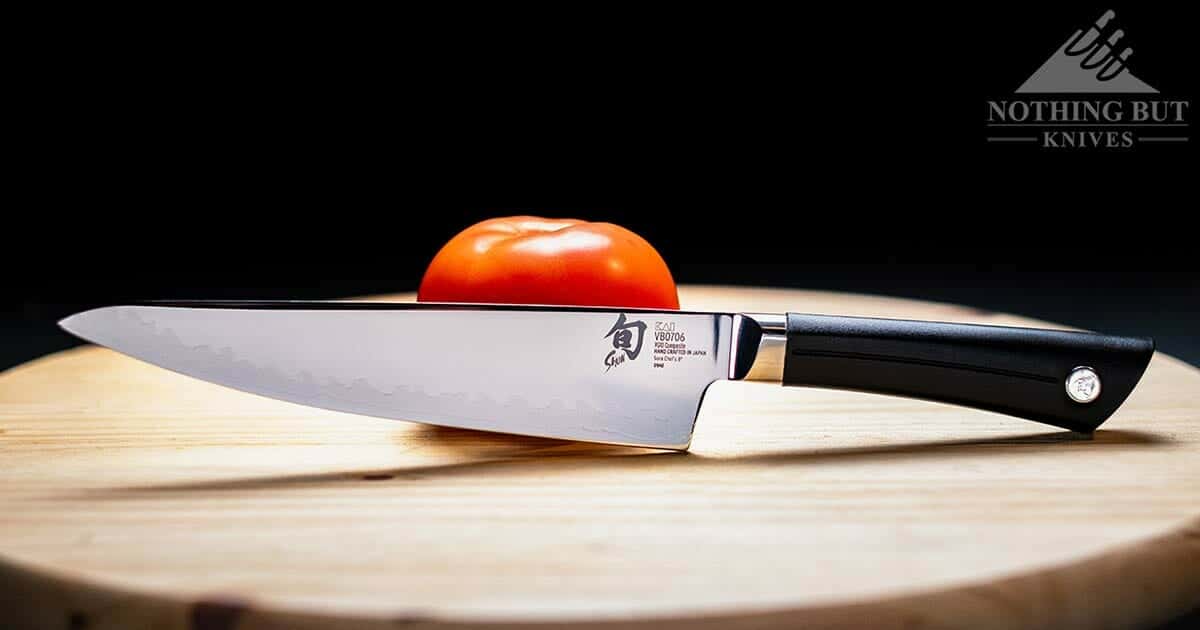
Also, as one of the more reasonably priced Shun sets, the Sora line is worth considering for anyone thinking about trying Shun knives out and the Shun Classic stuff doesn’t seem like your thing. It’s a pretty small series right now. It mostly has different kinds of chef and utility knives (both Japanese and Western), but Sora is fairly new, and I have a feeling they’ll be adding more knives as this series becomes more popular.
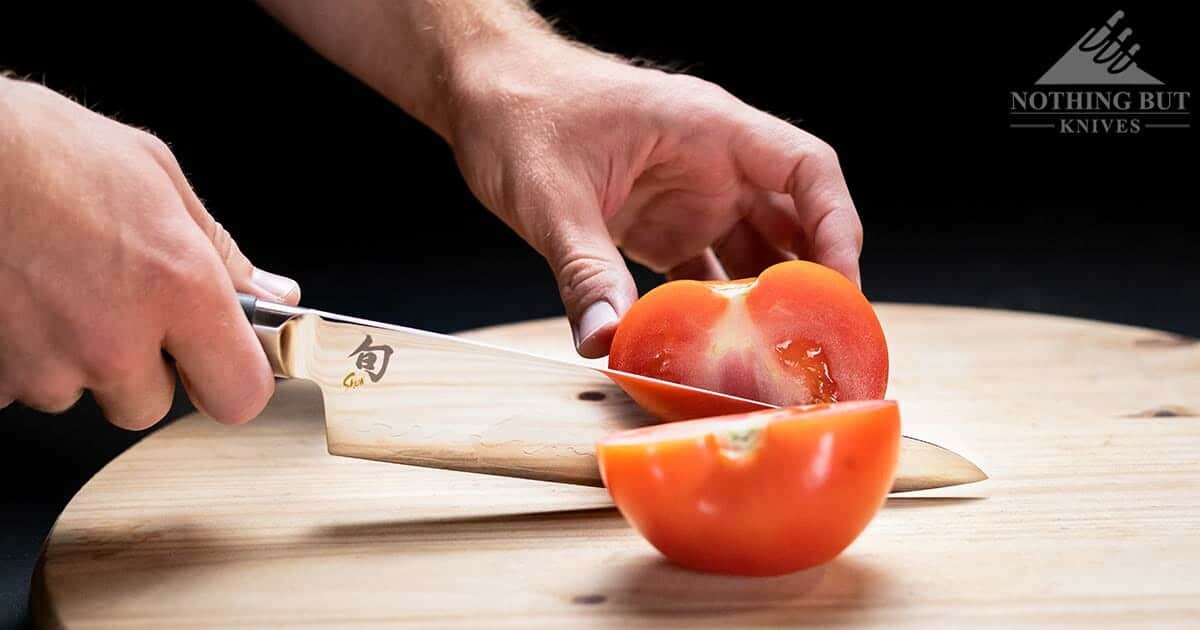
Shun offers the Sora set in 3 different sizes of block sets (a pattern you’ll see repeated in some of the other series):
- the Sora 3-Piece Build-a-Block set, which has the Sora chef knife, honing steel, and a 6-slot knife block;
- And the 6-Piece Basic Block set you see pictured above.
- They also have the 2-Piece Chef’s set, which is just the chef knife and the paring knife, and is likely the cheapest combination of Shun knives you can find anywhere.
Sora 5 Piece Student Set
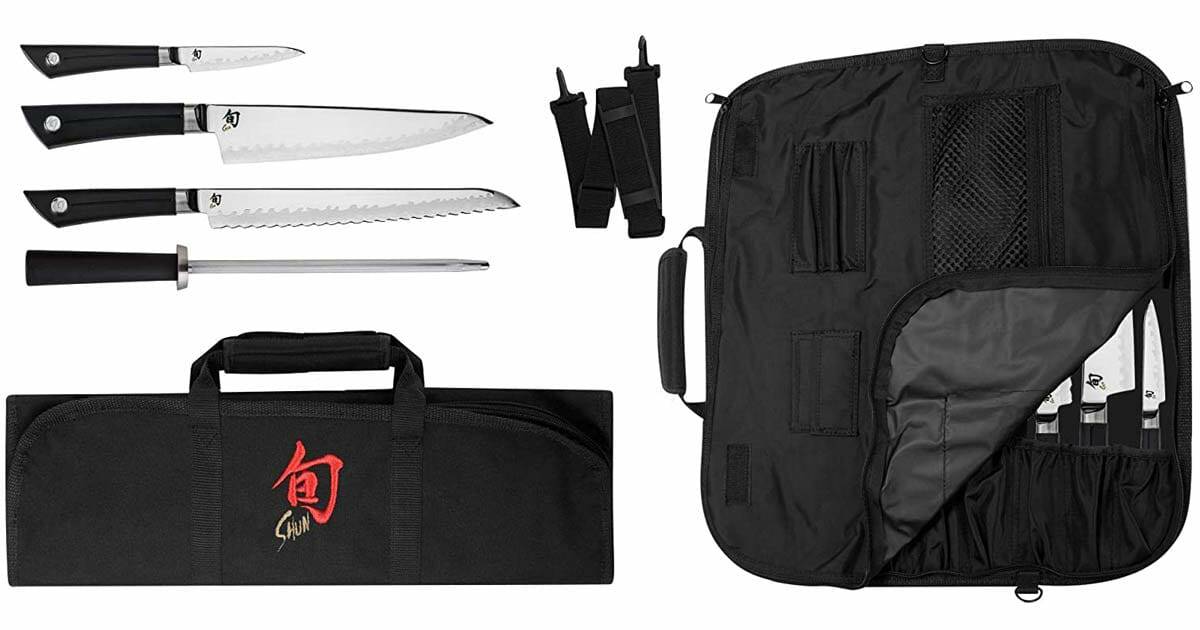
- Set Includes: 8″ chef knife, 3.5″ paring knife, 9″ utility, Shun honing steel, 8-slot Shun knife roll.
The Sora Student set is probably the most cost effective Shun set you can buy. You get the three main styles of knife used for most cooking tasks along with a honing rod designed with an angle guide for 16 degree edges. It features all the same steel and handle materials of the Sora set, just in a smaller, more portable package. This is a good way for people just starting out with cooking to dip their toes into high-end territory.
Classic
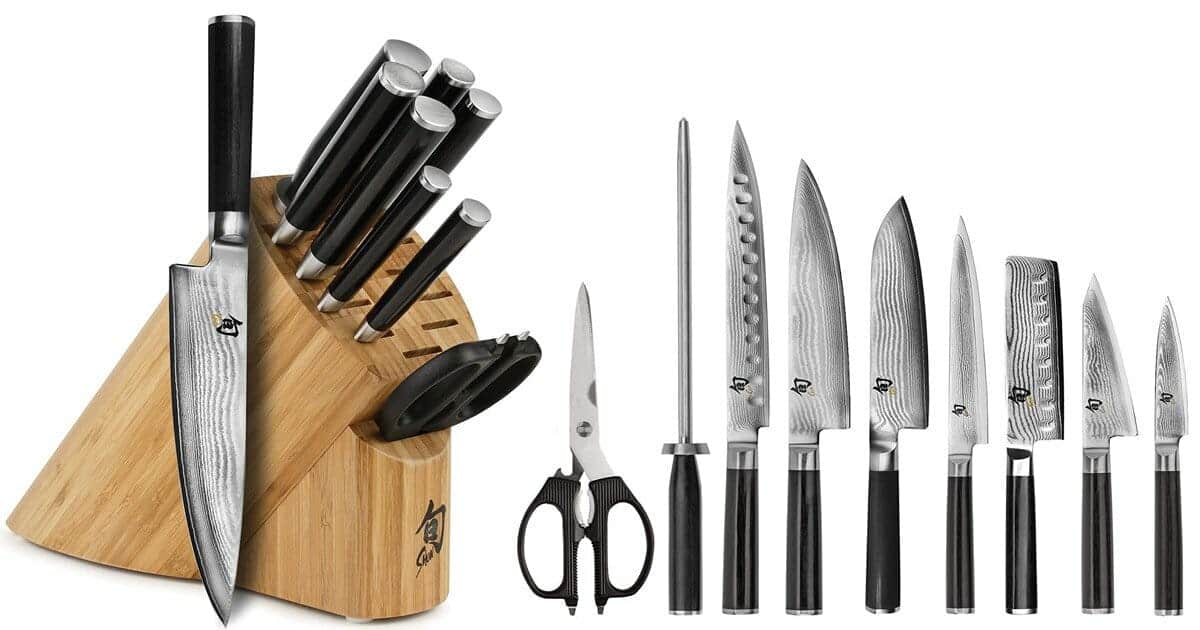
Shun Classic 10 Piece Block Set Specifications
| VG-MAX steel core |
| Rockwell hardness 60-61 |
| D-shaped Pakkawood handles |
Pros
| Wide variety of knives |
| Good edge retention |
| Easy to find sets |
Cons
| Less comfortable in the left hand |
| Least precise cut of the Shun sets |
Set includes: 8” chef knife, 7” santoku knife, 9”hollow edge carving knife, 6” utility knife, 5” hollow edge nakiri knife, 4.5 inch Honesuki knife, 3.5” paring knife, Shun multi-purpose kitchen shears, 9” combination honing steel, 13=slot bamboo knife block.
This is Shun’s first and largest series. It includes a wide variety of both Japanese and Western-style knives, which is a range of options you’ll only find in a couple of their other series. In that sense, this is not what you’d call traditional Japanese cutlery.
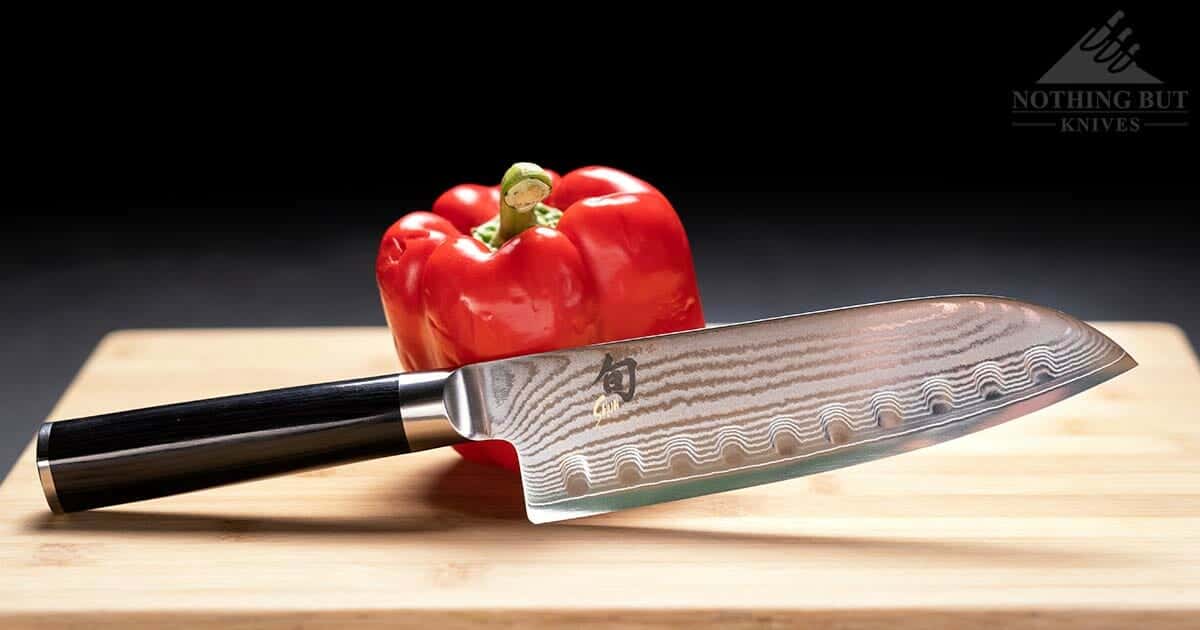
If you’ve ever wanted to find the closest thing to real Damascus steel in the modern age, though, this is probably it (along with some of these other Shun sets you’re about to see). The blades of Shun Classic knives are made with a VG-MAX core that’s folded with lesser high carbon steel to add tensile strength similar to what’s going on in the Sora line.
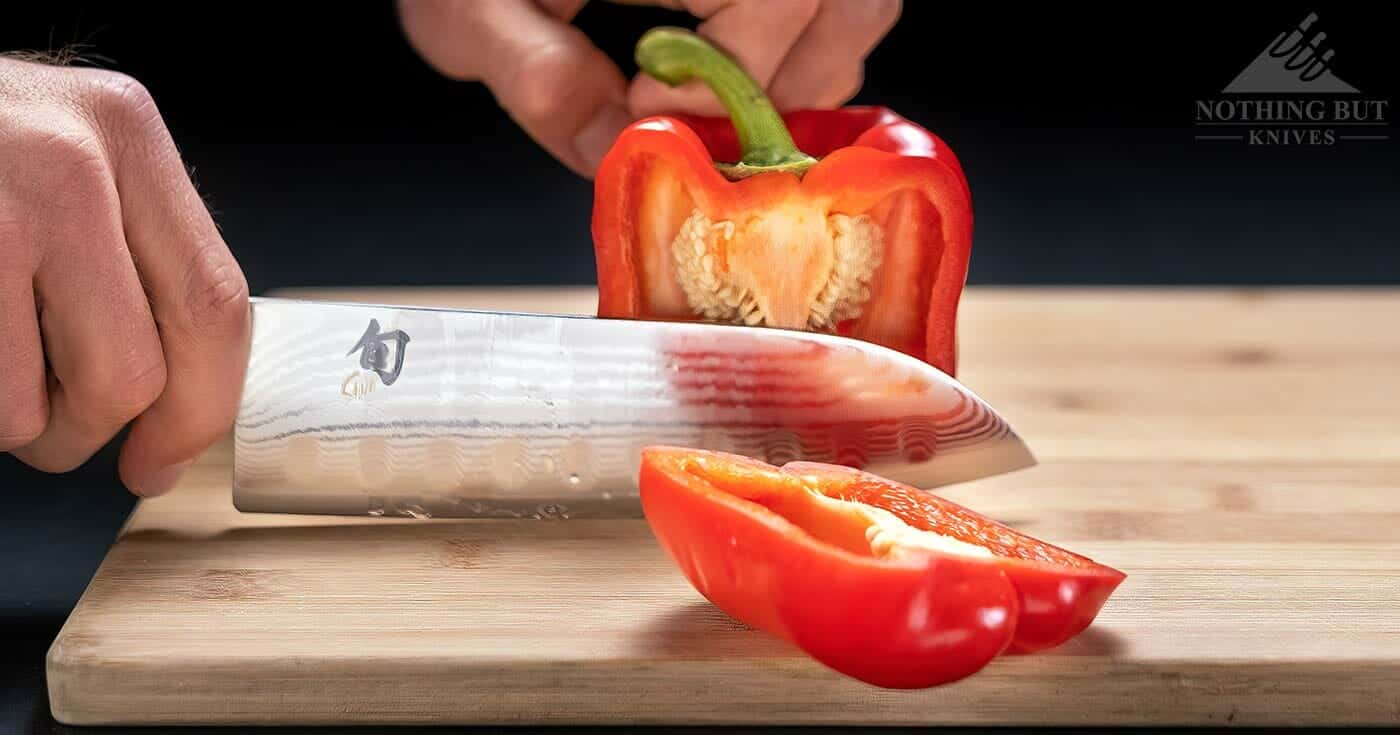
All the Shun Classics are made with a double bevel grind. On the bad side, that means these knives aren’t as ideal for things like sushi or a lot of the finer cutting you need to do for some Japanese dishes. On the good side it means that edge will last longer and there’s less chance of it chipping, which, thanks to the hard steels and thin blades they make, tends to happen easier with Shun than some other companies. Because of that, you could think of the Classic series as a sort of one-size-fits-all entry series compared to the other increasingly specialized sets made by Shun, possibly with the exception of their Sora series.
Shun offers a few different Classic sets, but it can also be fun to build your ow, We recommend stating with the Shun Classic 8 inch chef knife, The Classic 7 inch Santoku Knife and the Classic 3.5 inch paring knife.
- Currently they offer 4 block sets aside from the 10 piece set shown above:
- The 3-piece Build-a-Block set which includes the chef knife, honing steel and a 6-slot block;
- the 5-piece Starter set, which includes the chef knife, utility knife, paring knife, honing steel, and 6-slot block;
- the 7-piece Essential block, which adds on the shears and bread knife;
- and the 9-piece Chef’s Choice set which adds on the Santoku, slicing knife, boning knife, and the much larger 11-slot block.
Classic Blonde 5-Piece Starter Set
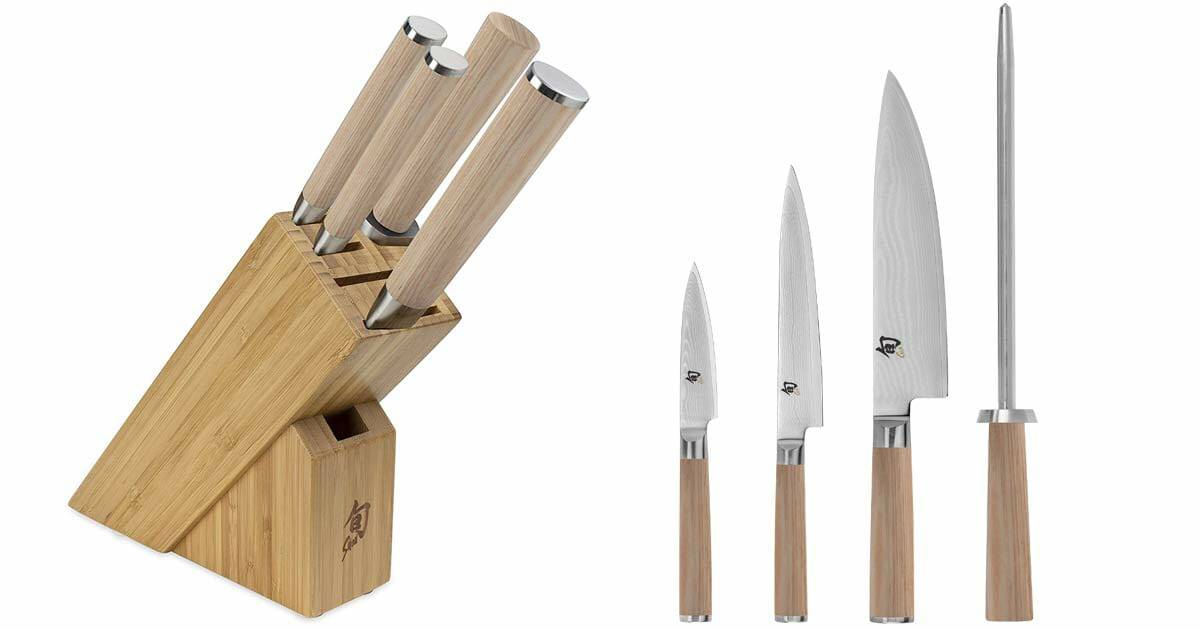
Set Includes: Chef knife, utility knife, paring knife, honing steel and a 6-slot storage block
The Classic Blonde series is exactly the same as the original Classic series, but with britght-toned wood handles. The options are a lot more limited in this color, which is why they only offer it in the one block set, but it’s also very new. I suspect that as popularity grows they’ll end up making a complete copy of everything under the Classic series into the blonde version.
Classic Starter Sets
There are currently three different kinds of starter sets under the Classic series: the 2-piece, the 3-piece, and the carving set.
The 2-piece starter is just the 8″ chef knife and the 6″ utility knife in the Classic style, and the 3-piece starter adds on the 3.5″ paring knife so you’d have all your basics covered with small and large knives.
The 2-pieces carving set is a little different with a 9″ slicing knife and a carving fork. This is what you want for the turkey on Thanksgiving.
It’s important to remember that all these starter sets only come in boxes but no block or carrying case, so it’s best if you get them as an addition to the block or case you already have.
Classic 8 Piece Student Set
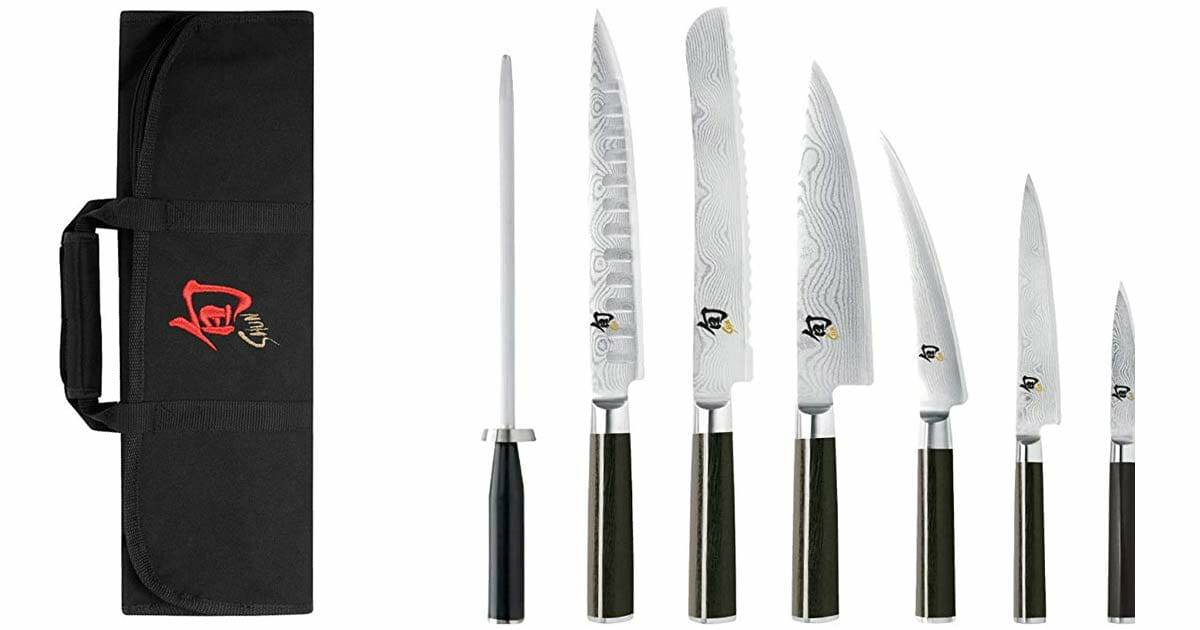
Set includes: 8″ Chef knife, 3.5″ paring knife, 6″ utility knife, boning knife, 9″ bread knife, 9″ slicing knife, Shun honing steel, 8-slot roll case.
This goes a little beyond the bare essentials most students will actually need. It’s a fantastic set to start out with, even if the bread knife seems like an unnecessary addition. It still gives you high quality tools for dicing, chopping, and fabricating your way through the kitchen and leaves two slots empty for you to add any other specialized knives you might need down the road.
Classic 4 Piece BBQ Set
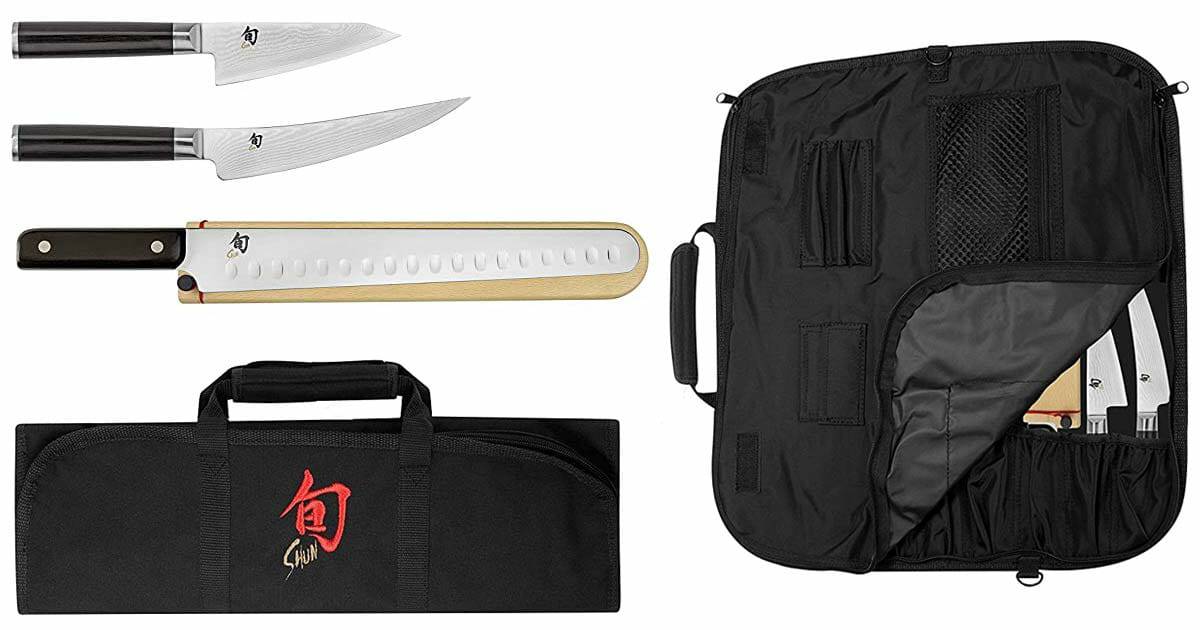
- Set Includes: Honesuki knife, boning/fillet knife, brisket knife, 8-slot knife roll.
This is a very protein-focused set. It essentially provides you with two kinds of boning knives (the honesuki knife is a Japanese style boning knife that’s good for poultry and fish), and a long brisket knife for slicing off thin pieces of meat. It’s not exactly a complete grill master set, but it will get you a long ways it preparing meat and parceling it out.
Classic Steak knife Set
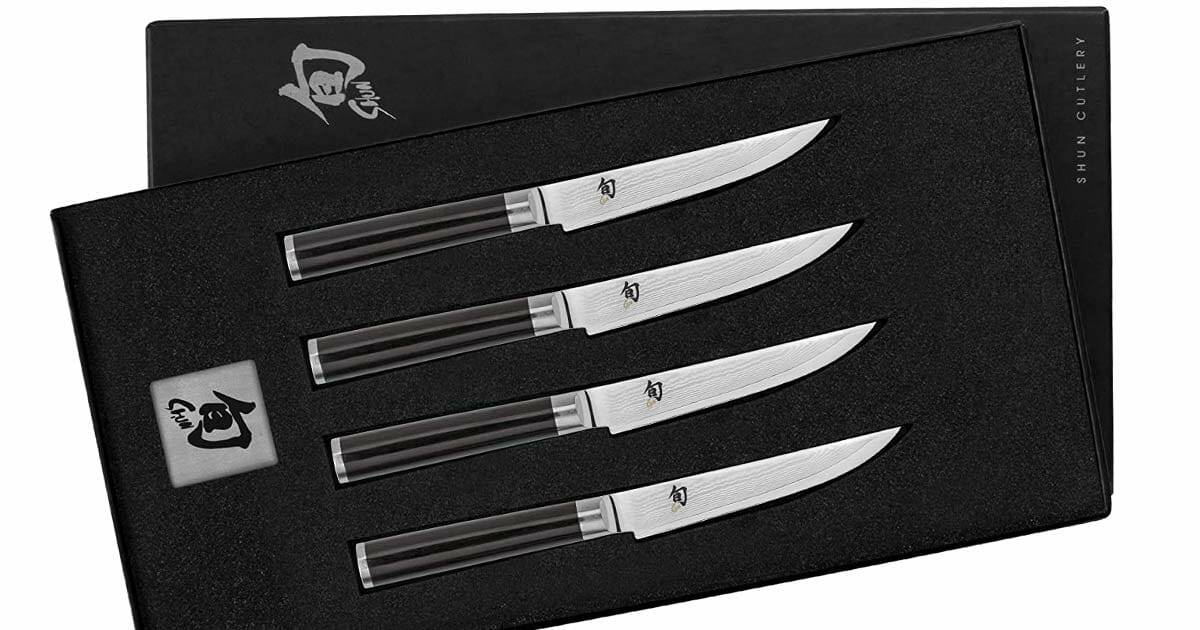
The efficient simplicity of the Classic series transitions well into steak knife form. The handles are comfortable and the blades cut well enough that your guests won’t have any trouble with whatever slabs of meat you put in front of them. You can get them in either a 6-piece gift box or a free-floating 4-piece set, which is an option you’ll see again with the Kanso and Premiere series of steak knives.
Dual Core
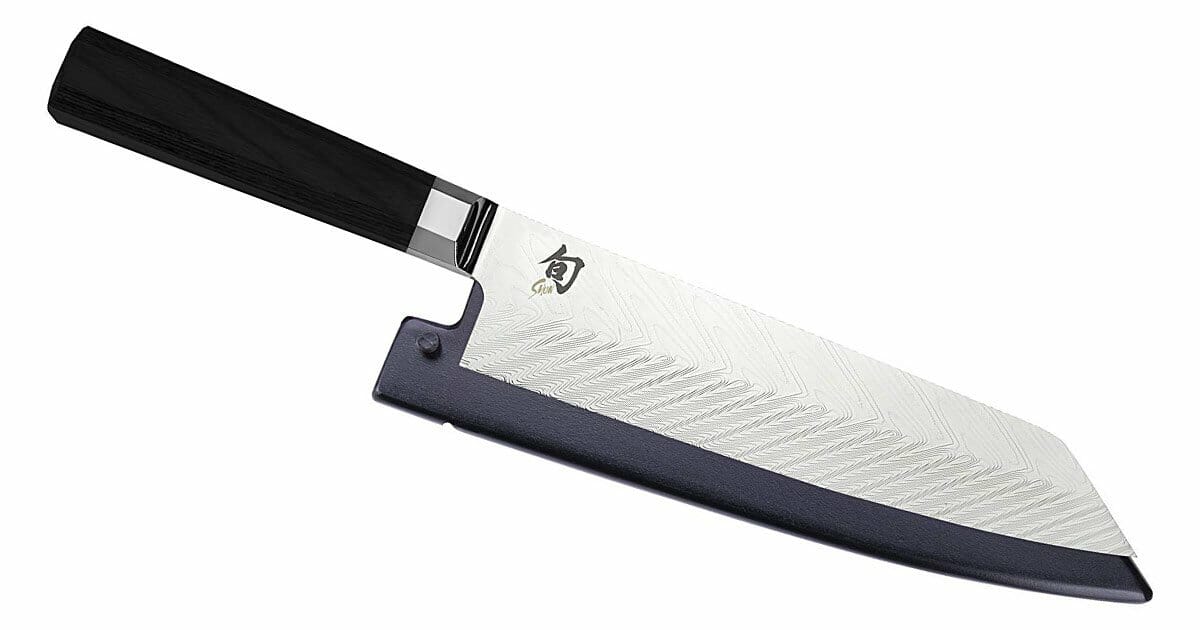
Specifications
| VG-10/VG-2 steel |
| Octagon shaped Pakkawood handles |
| Double bevel edge |
| Rabbeted tang |
Pros
| Very good edge retention |
| Less chance of chipping |
Cons
| Fairly expensive |
| Not usually sold as a set |
The Dual Core series feels like the logical next step up from the Classic set. The name comes from the steels folded together in the blade: VG-10 and VG-2. These are both high-end steels woven together more or less equally as opposed to the VG-MAX in the Classic set laced with some nameless high carbon substance. This makes the Dual Core knives incredibly strong in terms of edge retention, but they’ve also forged them in a way that’s supposed to keep the edge cutting sharp as it wears away. I’m not really clear on the science of the thing, but as I understand it each steel alternates in a wave pattern along the edge and take turns at cutting, as it were, as the whole edge wears away.
If it were any other company I would start getting suspicious. Two quality steels woven together to keep and edge sharp longer sounds like a gimmick, but if anyone is going to do something like that properly so it actually works, it’s Shun. They might be doing expensive work over there in the hand-crafted magic shops of Japan, but it’s always good work.
This is not a very large series right now. In fact it’s even smaller than the Classic Pro. It’s only a handful of traditional Japanese knives and all of them are fairly large with the exception of the honesuki knife.
Kanso
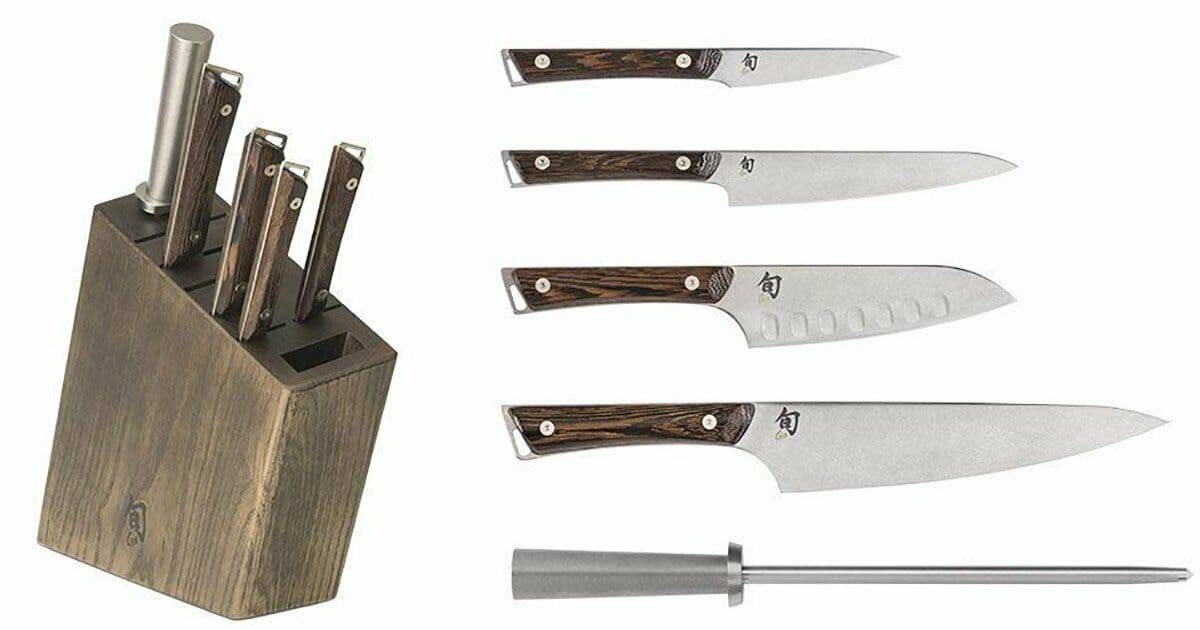
Shun Kanso 6 Piece Block Set Specifications
| AUS10 steel |
| Heritage finish |
| Contoured Tagayasan wood handles |
| Full tang |
| Double bevel grind |
Pros
| Rustic look ages well |
| Simple design means easy maintenance. |
| Sets are easy to find |
Cons
| Handles can be a little rough feeling compared to the other Shun knives |
Set includes: 8” chef knife, 5.5” santoku, 6” utility, 3.5” paring, combination honing steel, 8-slot wood block.
I like this line mostly because it stands out from the rest of Shun’s knives. It doesn’t look as polished and perfect. It looks like it’s actually meant to be used and stained rather than set on a pedestal with soft lighting.
That rustic aesthetic does come with one possible problem, though. A couple people say the wood handles feel rough and uncomfortable because they aren’t smoothed and oiled. That’s certainly something you can fix yourself easily enough with oil and sandpaper if it bothers you, but when you’re dropping four to six hundred on a set it really seems like you shouldn’t have to make your own improvements.
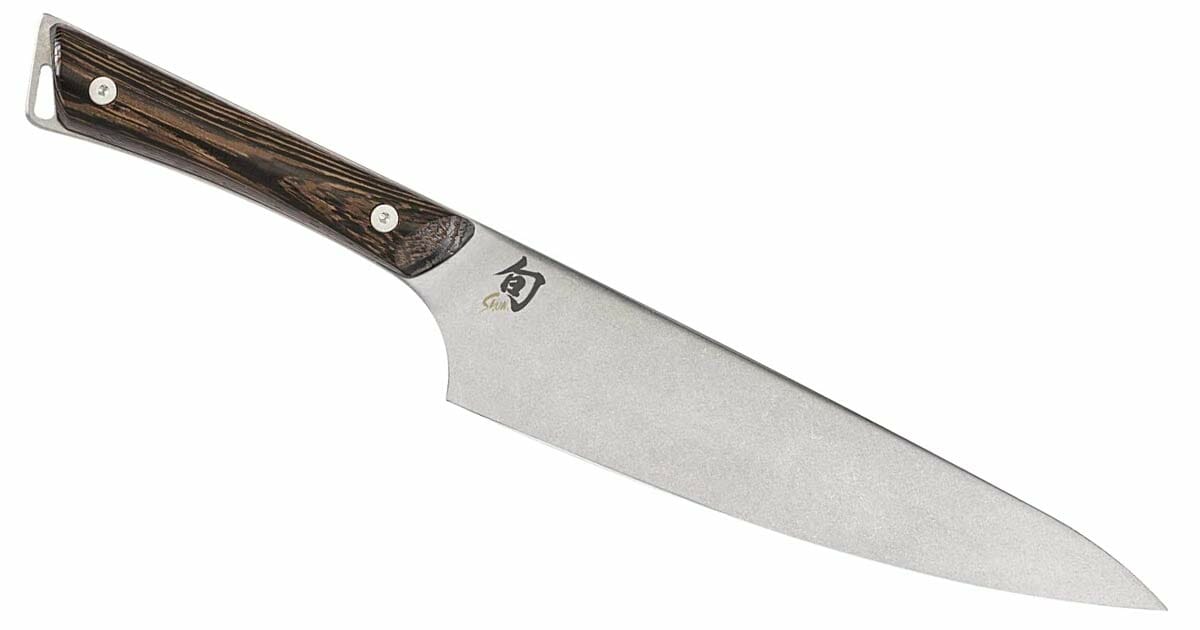
If the feel of the handle doesn’t bother you too much, though, the Kanso knives will definitely age better than other Shun knives. They’re made to take scratches and stains without getting ugly, and the Aus10 steel is a little tougher than VG-10 when the heat treatment is right.
The Kanso series also has a little more variety. It has a couple western style blades like a paring knife and a utility knife just kind of modified into a Japanese-ish aesthetic. That’s good, because it’s a lot harder to find knives from other series that would match this block. All in all, Shun’s Kanso knives probably aren’t the most practical option on here, and the fact that they don’t offer them in a student starter series leads me to believe Shun intended for these knive for the serious home cook who wants cool looking knives, rather than the tired chef in the restaurant.
Within the Kanso series they currently offer two other block sets, but they come in different blocks from the 6-piece pictured above:
- The 3-Piece Build-a-Block set, which comes with the Kanso chef knife, honing steel, and a 6-slot block that you’ll probably recognize from the smaller Classic series blocks;
- and the 5-Piece Starter set, which adds on the paring knife, and the utility knife in the same 6-slot block.
Kanso 4 Piece BBQ Set
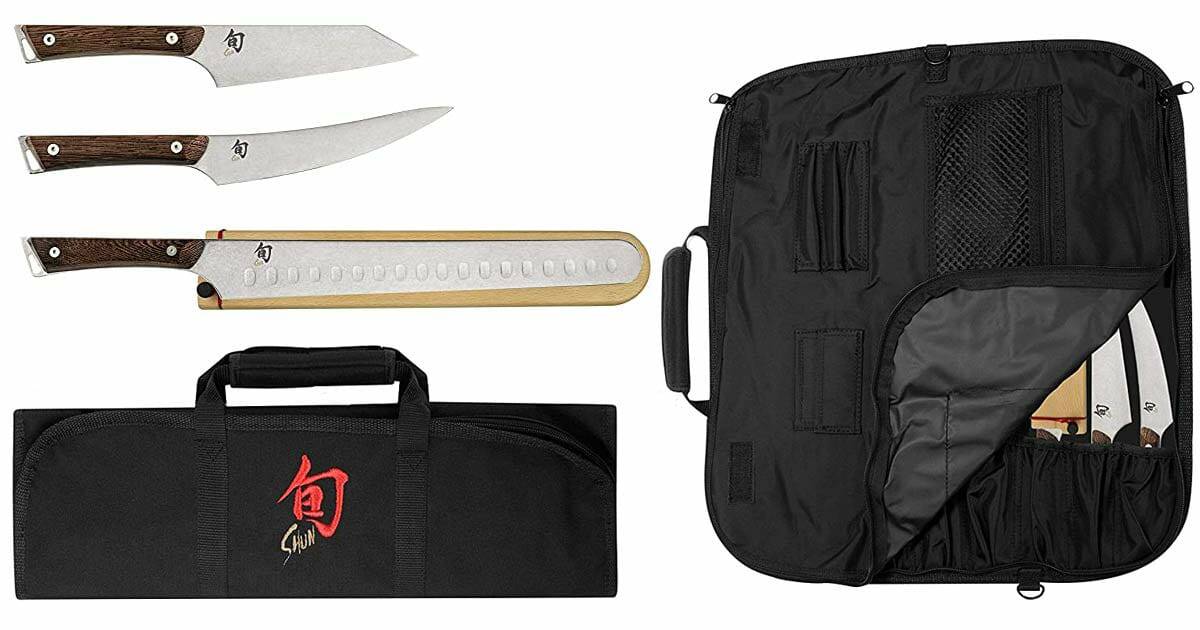
- Set Includes: Honesuki knife, boning/fillet knife, brisket knife, 8-slot knife roll.
The Kanso BBQ set gives you the same range as the Classic BBQ, but the rustic wooden handles and slightly tougher AUS-10 steel might feel like a more appropriate choice to keep next to your grill. In a situation where a lot of blood and barbecue sauce are likely to get dashed around, it makes sense to use knives that were made more or less to get scratched and stained without the overall aesthetic looking worse for wear.
Kanso 6 Piece Steak Knife Set
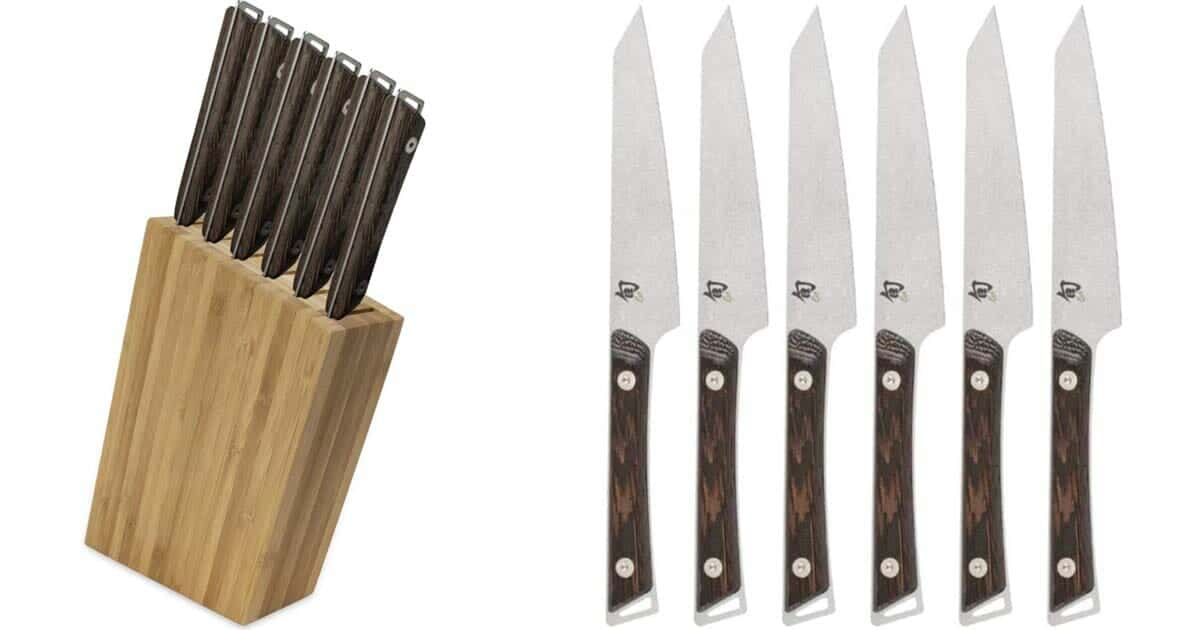
You better believe they make steak knives in the Kanso series. Providing hardwood handles that actually look something like what you’d find in a barbecue restaurant, only much much nicer, makes at least as much sense as the BBQ set. They offer this steak knife set as a 4-piece which makes the price a little more reasonable, but they don’t come in the storage block at that size.
Premier
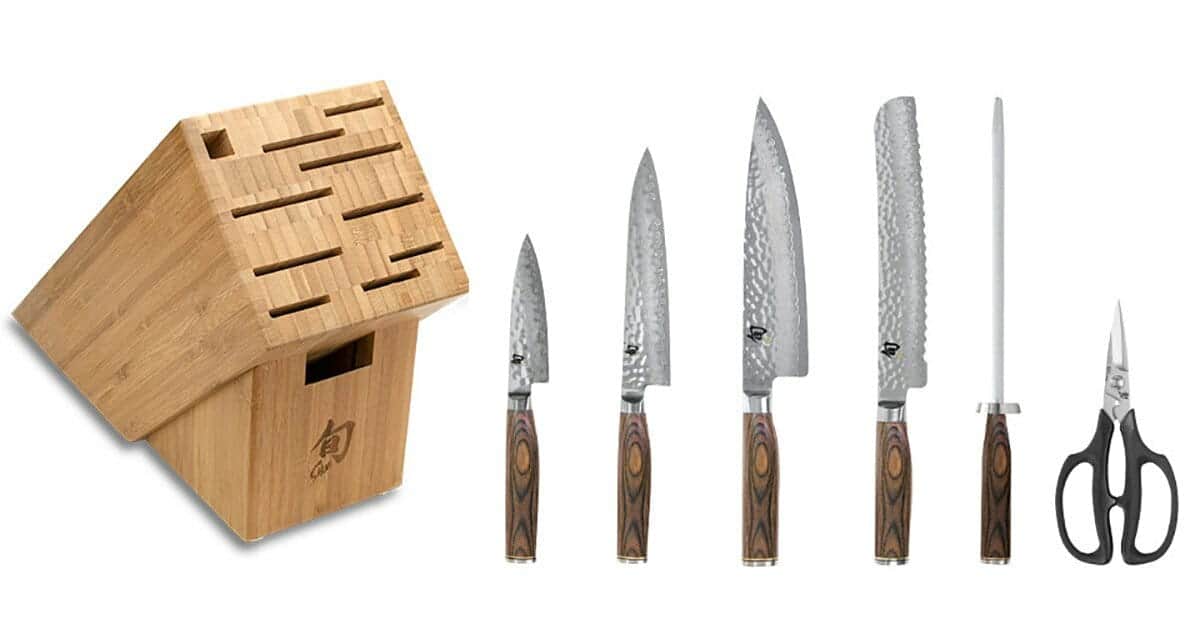
Shun Premiere 7 Piece Block Set Specifications
| VG-MAX steel core |
| Double bevel design |
| Hammered finish |
| Contoured Pakkawood handle |
Pros
| Smooth cut |
| Well balanced |
| Easy to find a set |
Cons
| Thin blades are a bit more prone to chipping |
Set includes: 8” chef knife, 9” bread knife, 6.5” utility knife, 4” paring knife, herb shears, combination honing steel, 11-slot bamboo block.
Take the Shun Classic set, now give it round handles and hammer-finished blades. That’s more or less what the Premier set is since they’ve taken a similar approach to a VG-MAX steel layered with lesser carbon steels for strength.
The other added benefit of this series, though, is that the hammered finish does a lot to cut drag and keep food from sticking to the blade. The handles also stand out with a walnut finish. It’s the same pakkawood material Shun uses in most of their other sets, but they made the refreshing decision to provide an aesthetic middle ground between the rustic look of the Kanso and the classic black of everything else they make.
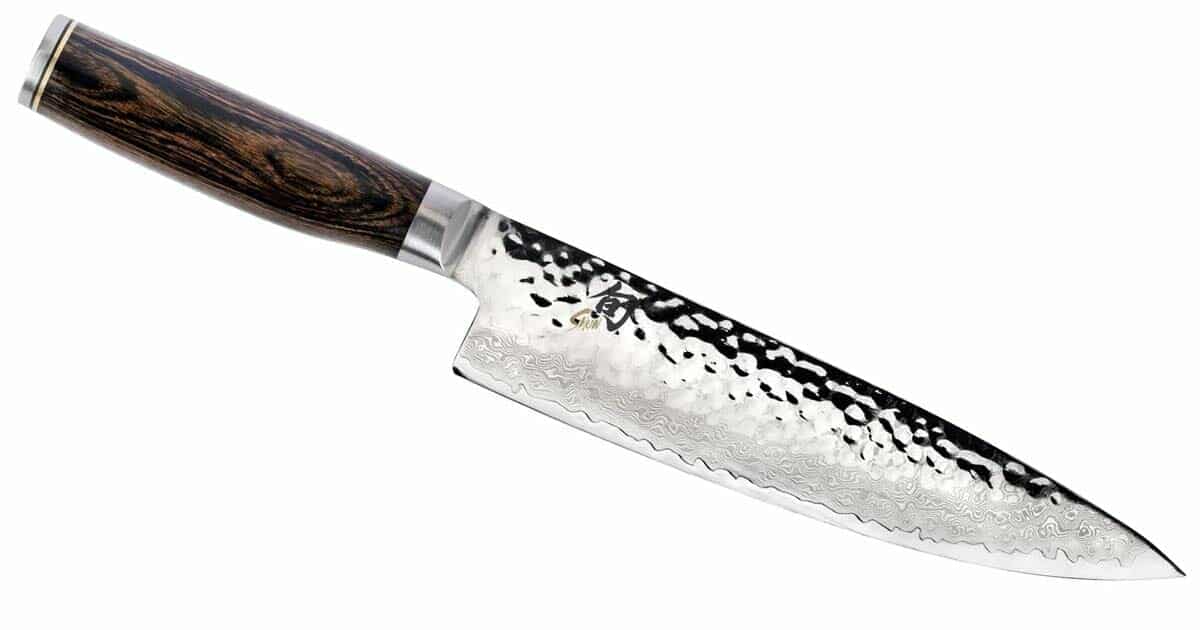
Interestingly, this is one of the largest series made by Shun. They have most of the standard line of Japanese knives, but throw in a few different sizes of western chef knives and even steak knives into the mix. You can cover a lot of different culinary ground if you’re just getting Premier knives.
Be aware, though, the hammer finish and thin blades do make it a chipping hazard. As with all well-made tools, these will perform beautifully for a long time if you treat them right, but for the less experienced, remember these need to be treated with extra care.
Currently Shun offers the Premiere series in 5 different block sets:
- The Premiere Build-a-Block set, which comes with the Premiere chef knife and honing steel in Shun’s basic 6-slot block;
- the 5-Piece Starter set, which adds on the utility knife and paring knife in the same block, but they also offer it with the Dark Slimline version of the same block;
- the 7-Piece Essential set, which adds on the shears and bread knife in the 11-slot block;
- the 8-Piece Professional set, which adds on the Santoku and slicing knife in the 11-slot block.
If you want to learn more about the Shun Premier series performance in the kitchen check out our Shun Premier 8 inch Chef Knife Review.
Premiere Starter Sets without a Block
Shun offers two different starter sets just straight in a box without any other way to store them:
The 3-Piece Starter Set, which has the Premiere chef knife, utility knife, and paring knife;
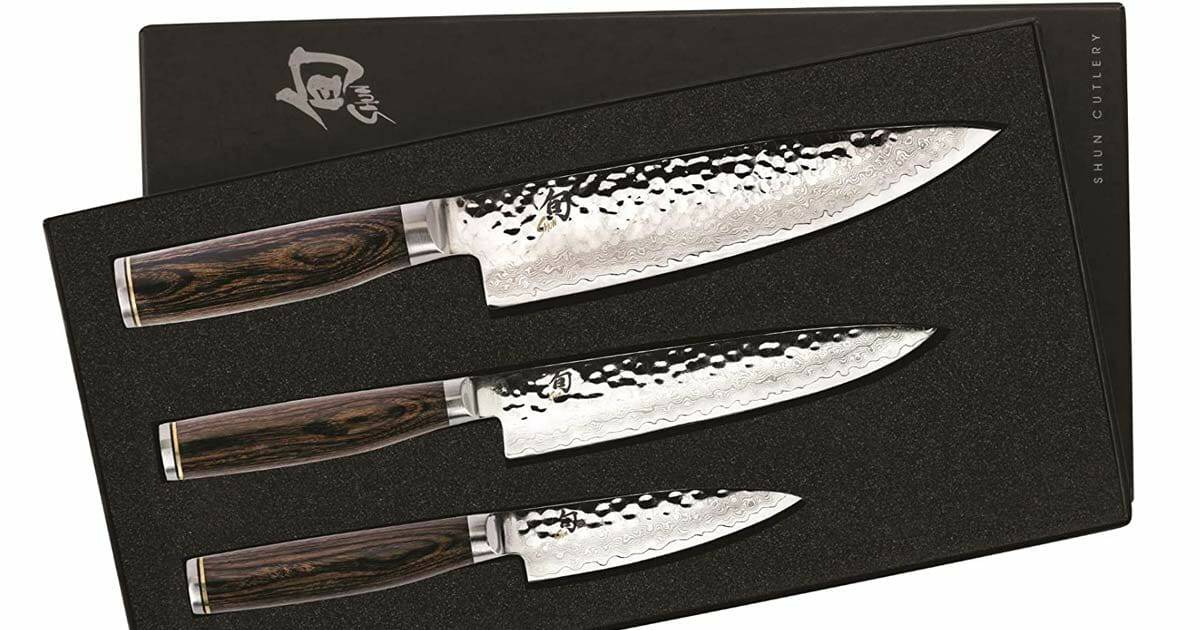
and the 2-Piece Carving set, which, like the Classic version, has a slicing knife and a carving fork.
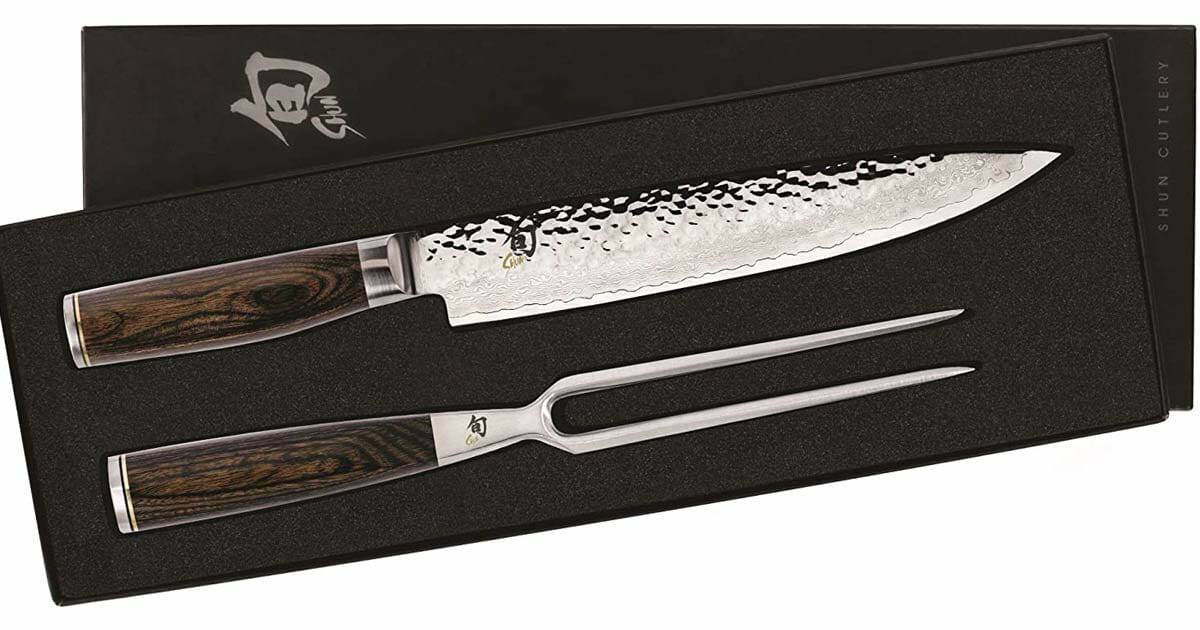
Premier Steak Knife Set
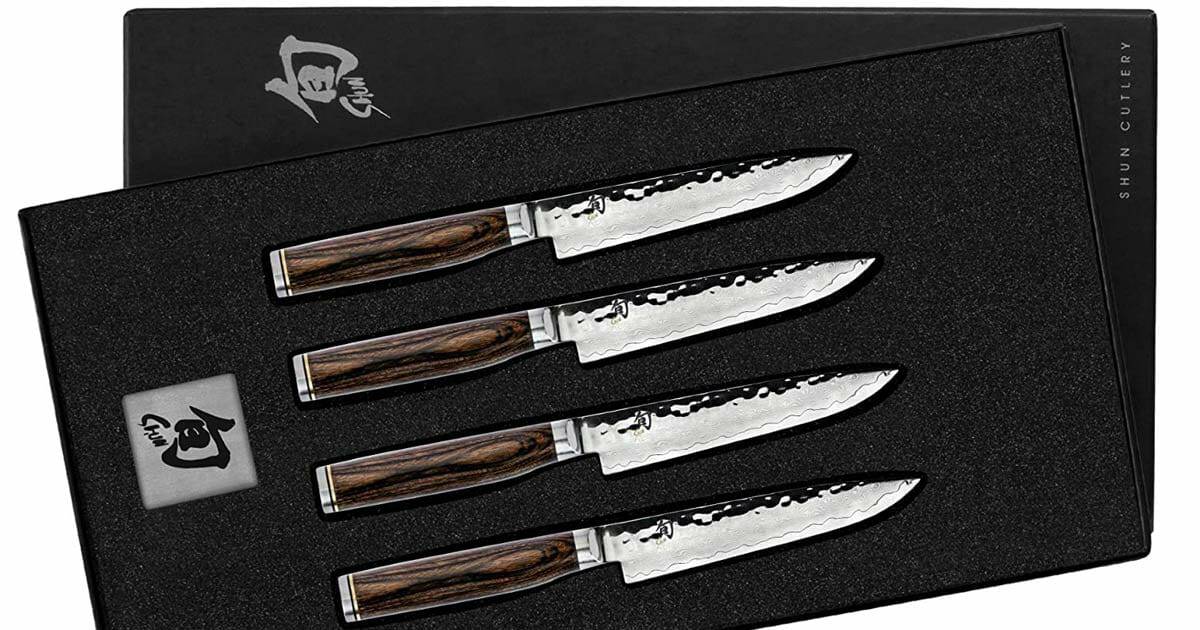
You’ve got the option of a 6 piece or a 4 piece in the Premiere series, which is in keeping with the options under the Classic and the Kanso series. But, again, you usually only get the box with the 6-piece set. The Premiere steak knife set is also the most expensive that Shun offers, but it’s also probably the most comfortable set and it offers a more hand-filling compromise between the sheer black of the classic set and the thin, rustic look of the Kanso.
Shima Steak Knives
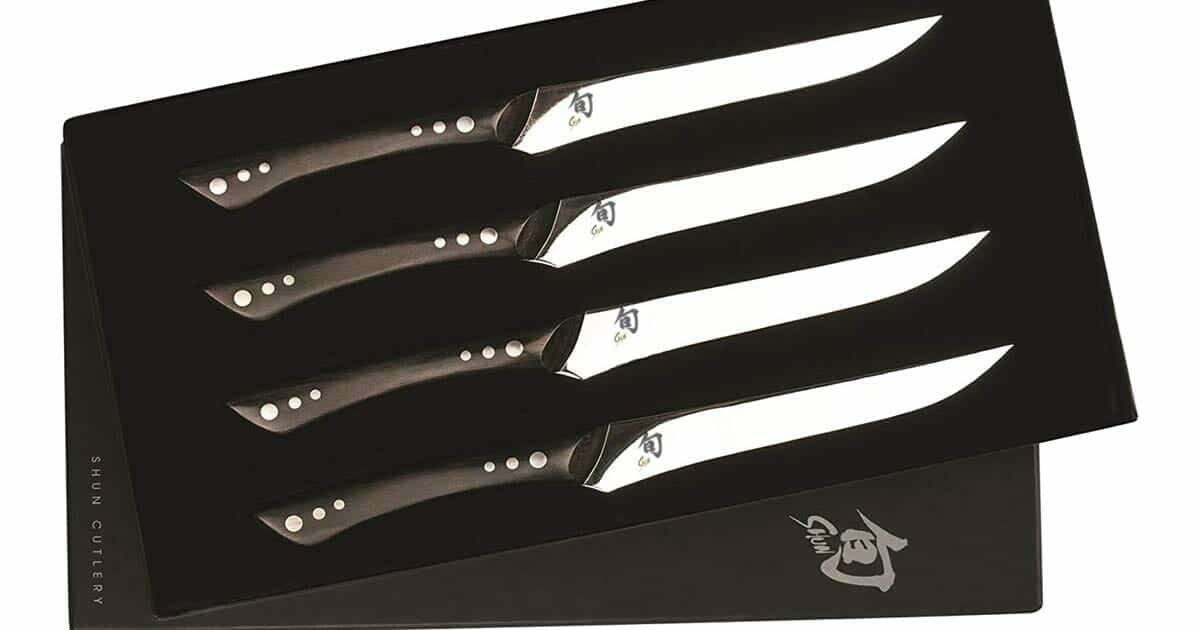
| 5 inch blades |
| AUS8 steel |
| Riveted Tagayasan or Pakkawood handles |
Far be it from Shun to stop at just a two or three different kinds of steak knives. The Shima steak knives are named after the renowned Shima Steakhouse in Tokyo, so you’re not likely to see any branching out under the Shima category. This one is all about steak. It comes in two options: one in natural wood, and the other in black Pakkawood. The ergonomics will be the same between the two, but the texture might differ slightly.
Besides that, these knives use the high carbon AUS8A steel which I haven’t seen used in any of the other Shun sets unless it’s one of the steels they use in one of the dual-folded series. It’s usually a very soft steel unless put under a pretty strict heat treatment process (which Shun likely has). So what you have here in these knives are very sturdy blades that will probably need to be honed or sharpened a little more than your other Shun knives, depending on how often you’re actually eating steak day to day.
Are Shun knives more Prone to Chipping
Shun knives are not any more prone to chipping than most other Japanese knives. The nature of Japanese kitchen knives is to be thin and hard, and that makes them a lot more frail than most consumers are used to.
The reason Shun has picked up a reputation for making chippy knives is that they’re popular across a broad range of users who don’t all understand the nuance of using Japanese cutlery, and Shun doesn’t always do a great job of educating those consumers on how to care and use their knives.
So in the interest of education:
How Should You Take Care of a Shun Kitchen Knife
It all comes down to hand washing and not cutting into anything that’s harder than the steel of the knife. Shun has a Use & Care section on their site that goes into okay detail, but here’s a table for a quick reference:
| DO | DON’T |
|---|---|
| Hand wash and dry any knife after use | Put any Shun knife in the dishwasher |
| Regularly hone and sharpen the edge | Scrape the edge across the cutting board |
| Cut in a smooth slicing motion | Cut bone or frozen foods |
| Store knives in a block, in-drawer knife tray, sheath, knife roll, or magnetic knife strip | Store the knives loose in a drawer |
There are exceptions to some of these. Obviously there’s no point in owning a boning knife if you aren’t going to cut into meat with bone still in it. And you can get away with scraping food across a cutting board if you do it with the spine of the knife, but it’s a dangerous habit to get into.
How to Hone and Sharpen a Shun Knife (and How Often)
Almost all Shun knives have a 16° double-bevel edge. They even sell honing rods with a guide at that angle. The main exceptions are their western-style chef’s knives which have a 22° edge, so anytime you’re honing or sharpening one of those just lift the spine up a little.
How to Hone
Place the honing rod point down on the counter, preferably over a wet cloth to keep it from sliding, place the edge of the knife along the steel then run the blade down the steel as you pull it from heel to tip. Do this about ten times on each side as a first pass, then try cutting through a piece of paper. If you cut along the whole edge without feeling a hiccup, the edge is good to go. Otherwise, try another pass at nine strokes each side, and keep going until the knife is cutting the way you like.
You can follow roughly the same pattern for stropping Shun knives, but the motion is in reverse. Pull back toward the spine with the edge along the leather, but don’t pull along the edge. Just work your way up to the tip, doing about 20 passes on each section of the blade.
How to Find the Edge Angle
There are sharpening solutions that have pretty good edge guides, but there’s a little trick to eyeballing the angle you need.
When you place a blade so it’s perpendicular to the honing steel or strop, it’s at a 90° angle. When you rotate it so the spine is halfway from that position you get a 45° angle. Half of that puts you in 25° territory which is good enough for western kitchen knives and most survival knives. But half from that angle gets you into the ballpark of Shun’s 16° angle.
It’s not a perfect method, but it’s a good start. Just make sure you pay attention to the way the edge feels every few passes.
How and When to Sharpen a Shun Knife
For most home cooks making two to three meals a day, you probably only need to sharpen a Shun knife (and most well-made Japanese knives) about once a year. If a knife isn’t biting int the skin of a tomato or easily passing through paper even after honing and stropping, it’s probably time to take a bit of steel off.
Shun offers free sharpening if you send your knives in, and it usually isn’t very expensive to have a local sharpener touch your knives up. But if you want to do it yourself, Shun recommends a minimum of a 1,000 grit stone. They have a decent video of sharpening instructions on their site, and there is no end of other good knife sharpening videos out there, so we won’t spend much time on it ourselves here.
What’s so Special about Shun Knives
The truth is they aren’t that much nicer than a lot of other Japanese kitchen knives out there. What’s special is the level of quality maintained through a large production process. But you likely wouldn’t find that most Shun knives perform that much better than something like a Tojiro DP in a side by side test.
There is a certain assurance of quality control and customer service that comes with buying a Shun knife that you might not get from smaller companies or makers. It’s the corporate Japanese knife, for better and worse.
That said, they do some interesting things with steel that are worth knowing about:
What Kind of Steel Does Shun Use
Shun knives mostly use a range of Japanese stainless steels, often in a Damascus or San Mai construction. Each of those are their own types of things, but they both basically mean there’s a certain amount of layering between at least two different steels in the blade.
Lately Shun has been making higher end knives with SG2 powder steel, which is considered one of the more premium stainless steels available for kitchen knives right now. Currently you’ll only see that in their Williams Sonoma exclusive series, though.
San Mai and the Composite Blade Technology
In San Mai steel there’s usually a soft, highly stainless steel wrapped around a harder core steel. Shun’s San Mai typically uses VG-10 as a core inside a layer of 420J. Although it’s a little different with their “composite blade technology”, which basically fuses the harder core to the 420J to make the cutting edge instead of fully wrapping the cheaper steel around. This apparently keeps costs down since they’re using less of the more expensive core steel without losing any of the performance. We won’t dive into the economic weeds of the thing, but there’s no denying that the Sora line is well priced.
What’s Going On with Shun’s Damascus Steel
Damascus steel is several layers of at least two different steels stacked, welded, forged, and folded together to create a unique pattern. In Shun’s case, it’s a traditional kasumi pattern that leaves slight waving shapes parallel to the cutting edge. It’s pretty subtle and difficult to see in photographs (especially compared to other Damascus patterns out there), but you’ll see it better in person.
There’s probably an argument to be made that Shun’s layered method gives their blades better edge retention or tensile strength, but we haven’t noticed much difference from mono-steel knives in our own experience. It’s really more about the look and craftsmanship required to make these kinds of blades well.
What are the Handles Made of
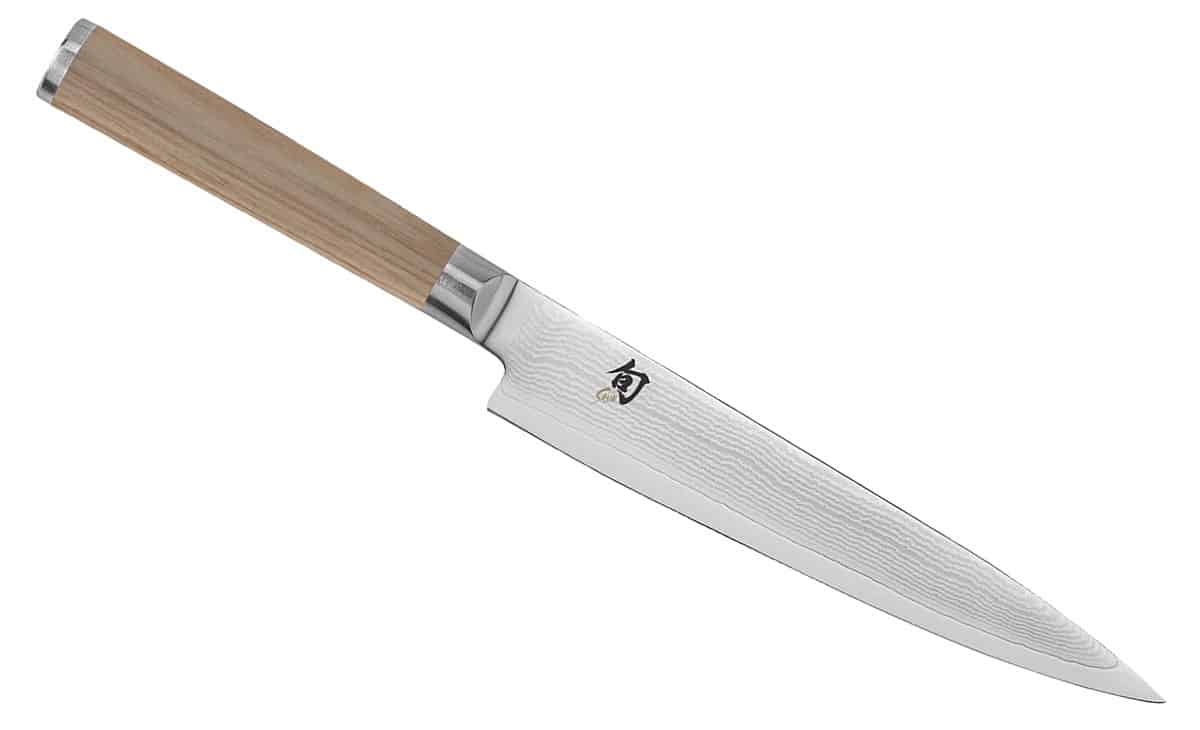
Shun knives mostly have stabilized wood for handles.
You’ll see the word Pakkawood thrown around a lot in the kitchen cutlery world. It’s just hardwood packed with resin so it doesn’t swell when it gets wet. It’s also a lot easier to clean than most other handle materials. The texture and color can vary quite a bit because the wood takes certain dye colors really well, and the amount of resin used to stabilize it will affect how plastic-y it feels.
On the budget side, you’ll see polypropylene handles, which is basically plastic, but before you snub your nose, keep in mind that this stuff not only makes knives cheaper, but a lot more lightweight besides making handles that are highly resistant to wear from acidic materials.
Tagayasen, or wenge, wood is a Japanese hard wood that was often used for making training swords. It’s difficult to work with, which is why you’ll typically see it on higher priced knives, but it is highly durable stuff and pretty resistant to swelling and wear.
What are the Shun Exclusive Knives
Williams Sonoma has been in pretty tight with Shun for a while. So much so that they’ve collaborated on several different knife series together. These are the Shun knives that you’ll only find through Williams Sonoma stores or their website.
Here’s a quick run down of those series:
| Kazahana | Basically the same as the Kanso series only with black Pakkawood handles. |
| Hikari | Knives with Dual Core steel, angled bolsters, and blonde Pakkawood handles. |
| Fuji | High-end knives featuring Damascus with an SG2 steel core and tagayasan wood handles |
| Kaji | Western-style hybrid knives with SG2 Damascus steel and ebony Pakka wood handles. |

Very informative
Tnxs